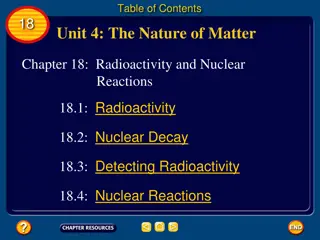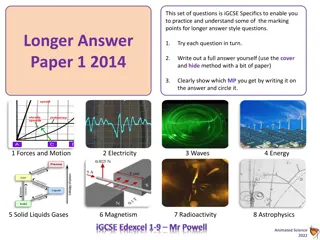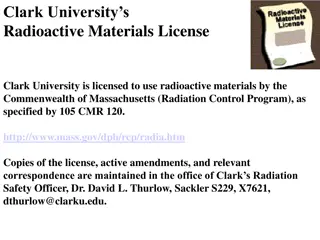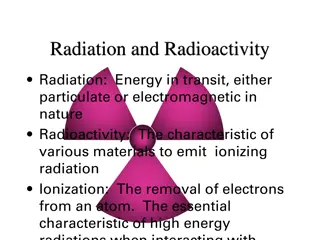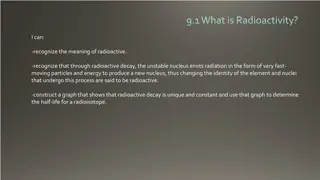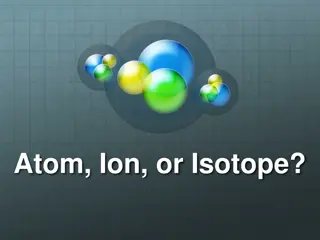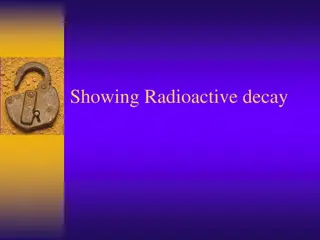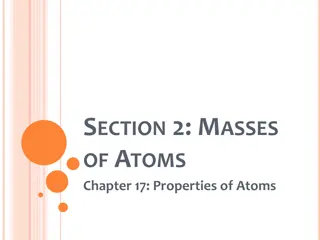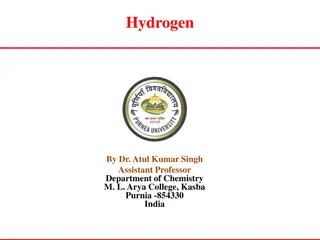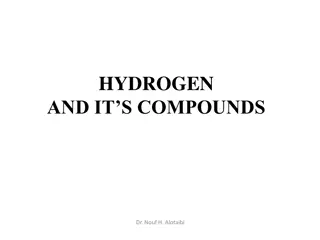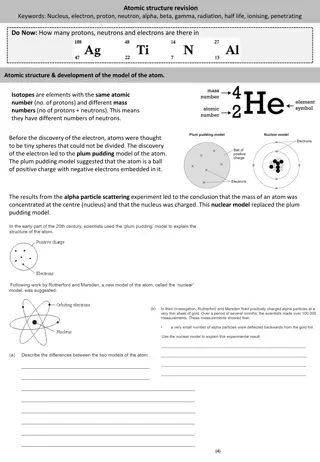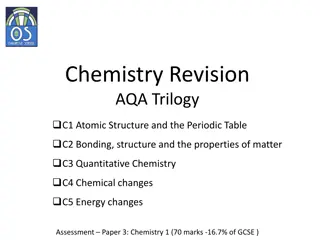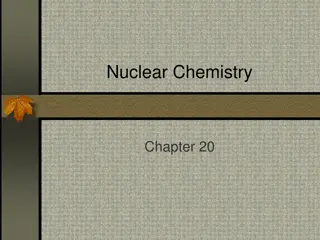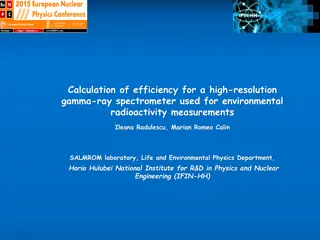Isotopes and Radioactivity
Isotopes are atoms with different neutron numbers, while radioactivity involves unstable nuclei emitting particles. Learn about alpha, beta, and gamma radiation properties, as well as atomic symbols and decay processes in this educational content.
Download Presentation

Please find below an Image/Link to download the presentation.
The content on the website is provided AS IS for your information and personal use only. It may not be sold, licensed, or shared on other websites without obtaining consent from the author.If you encounter any issues during the download, it is possible that the publisher has removed the file from their server.
You are allowed to download the files provided on this website for personal or commercial use, subject to the condition that they are used lawfully. All files are the property of their respective owners.
The content on the website is provided AS IS for your information and personal use only. It may not be sold, licensed, or shared on other websites without obtaining consent from the author.
E N D
Presentation Transcript
Radiation Dr. Walker
Objectives Describe isotopes as a function of number of subatomic particles in an atom. Describe and calculate half-life of a radioactive isotope. Describe alpha, beta, and gamma radiation with respect to penetrating power, shielding, and composition.
Isotopes Same atom, different number of neutrons All atoms of an element must have the same number of protons All hydrogens have 1 proton All heliums have 2 protons, etc., etc. The neutrons can be different 11H, 21H, 31H These are called isotopes
Atomic Symbols Review 11H, 21H, 31H How many protons and neutrons do each of these isotopes contain?
Atomic Symbols Review 11H, 21H, 31H How many protons and neutrons do each of these isotopes contain? 11H = 1 proton, 0 neutrons 21H = 1 proton, 1 neutron 31H = 1 proton, 2 neutrons
Isotopes Most isotopes are stable they do not break down Some isotopes are unstable and break down known as radioactive There are rules that govern which ones are unstable that you don t need to know Nothing with an atomic number greater than 83 is stable
Radioactivity Radioactivity Process where an unstable nucleus gives off one or more particles in the form of electromagnetic radiation Radioactive decay is a nuclear (not chemical) processes.
Particles Alpha ( ) Particle 42He nucleus Some radioactive elements give off a helium when they decay Stopped by a sheet of paper Example 23892U 23490Th + 42He
Particles Beta ( ) Particle A beta particle is an electron (0-1e) that results from the breakdown of a neutron 10n 11p + 0-1e Note: since the mass of an Electron is much smaller than a neutron Or proton, the mass number of an electron Is zero Multiple sheets of aluminum foil will stop a beta particle 23490Th 23491Pa + 0-1e +
Particles Gamma ( ) Ray High energy photon given off during fission and radioactive decay Contains no mass or electrical charge Requires several centimeters of lead or concrete for shielding http://www.gcsescience.com/prad10-gamma-nuclear-equations.htm
Fission The splitting of a nucleus of an atom into two or more fragments The previous examples of decay are examples of fission Nuclear power is generated by the fission of either Uranium or Plutonium (Dominion uses 23592U)
Fusion Combination of small nuclei to form larger nuclei 21H + 31H 42He + 10n + energy Generates more energy than fission, but harder to start and maintain Need REALLY high temperatures (40,000,000 C) Manner in which stars form and generate energy
Transmutation Conversion of one atom of one element to an atom of another element Fission, fusion are BOTH examples Transuranium elements All elements above atomic number 92 Also known as the actinides (from actinium) Made by neutron bombardment in a nuclear accelerator (like Jefferson Lab)
Transmutation Formation of transuranium elements 23892U 23992U + 10n (neutron capture) 23992U 23993Np + 0-1e (beta decay) 23993Np 23994Pu + 0-1e (beta decay)
Half-Life Half-life is the length of time required for half of a given sample of a radioactive isotope to decay Iodine-131 has a half-life of about 8 days. Every 8 days, it loses half its mass
Half-Life Examples of half-life Isotope Half-life 12.3 years 5730 years 14.3 days 7.1 x 108 years 4.51 x 109 years 24,400 years 3H 14C 32P 235U 238U 239Pu
http://www.ndt- ed.org/EducationResources/CommunityCollege/RadiationSafety/Graphics/ISU036.jp g
Half-Life Iodine-131 has a half-life of 8 days. How much iodine-131 will remain from a 64 g sample in 32 days? Each 8 days, divide by 2 Day 8, 64/2 = 32 g remaining Day 16, 32/2 = 16 g remaining Day 24, 16/2 = 8 g remaining Day 32, 8/2 = 4 g remaining (Answer!)
How to Calculate Formula for calculating half-lives Fraction Remaining = (0.5)n n = number of half-lives Previous problem Determine number of half-lives 32 days / 8 days (half-life) = 4 Determine fraction remaining (0.5)4 = 0.0625 Multiply fraction by original mass 0.0625 x 64 = 4 days (answer!)
Second Example What percentage of carbon-14 remains in a sample that is 2000 years old? (Half-life of carbon = 5730 years)
Second Example What percentage of carbon-14 remains in a sample that is 2000 years old? (Half-life of carbon = 5730 years) Determine number of half-lives 2000 years / 5730 days (half-life) = 0.349 Doesn t have to be a whole number! Determine fraction remaining (0.5)0.349 = 0.785 Convert decimal to fraction 0.785 x 100 = 78.5%
Everyday Applications Nuclear Power (235U decay) Smoke detectors enters the space, the alarm is triggered 241Am decay ionizes air between electrodes. When smoke Cancer treatments Rapidly dividing cells (like cancer cells) are more sensitive to radiation than normal cells
Exercises What radioactive particle requires the most shielding? What radioactive particle has the largest mass? The half-life of polonium 218 is 3.0 min. If you start with 20 grams of 218Po, how much will you have left after 12 min?
Exercises What radioactive particle requires the most shielding? gamma What radioactive particle has the largest mass? alpha The half-life of polonium 218 is 3.0 min. If you start with 20 grams of 218Po, how much will you have left after 12 min? 0 min 20 g 3 min 10 g 6 min 5 g 9 min 2.5 g 12 min 1.25 g (Answer!!)
Terms to Remember Terms to Know Isotope Alpha ( ) particle Beta ( ) particle Gamma ( ) particle Fission Fusion Half-Life Skills To Master Perform calculations involving the half-life of a radioactive substance.
In Your Textbook Particle Types, pp. 877-879 Half-Life, pp. 882-884 Fission/Fusion, pp. 888-891


